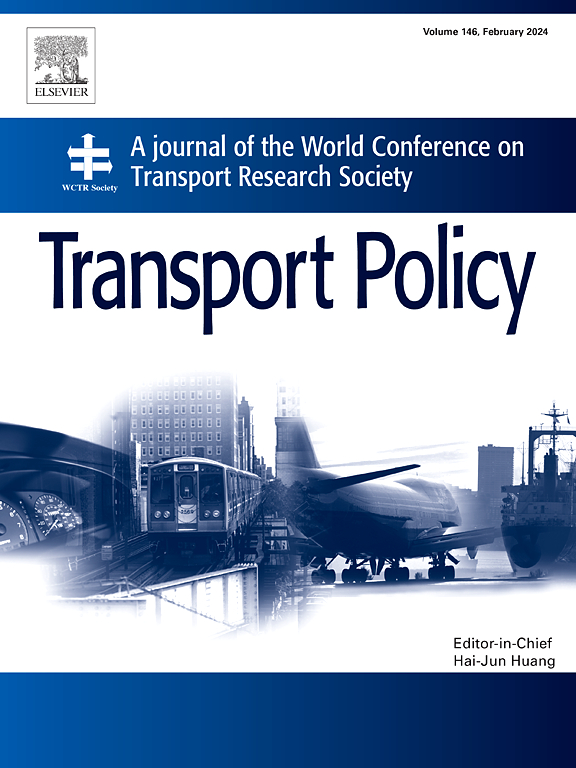How does policy awareness impact consumer preferences for passenger vehicles? A study from China
IF 6.3
2区 工程技术
Q1 ECONOMICS
引用次数: 0
Abstract
To reduce energy consumption and carbon emissions in the transportation sector, various incentives for promoting electric vehicle (EV) uptake have been implemented worldwide. However, little attention has been given to how individuals perceive EV-related policy incentives, and a knowledge gap may reduce the effectiveness of these incentives. The aim of this study is to discern how a deep understanding of fiscal incentives can also contribute to greater environmental benefits and how green product-related policy awareness is formed in developing countries. Taking a newly released purchase tax exemption for EVs in China as an example, this study compares consumer preferences over certain attribute levels of vehicles with and without detailed policy information via a randomized group design. A best‒worst scaling profile case experiment is embedded to elicit consumer preferences and detailed information about a newly released vehicle emission standard is also provided to avoid a knowledge gap on this regulation. The result shows that compared to the group without detailed policy information, those with information about tax exemption caps are significantly less attracted to hybrid EVs, larger sized and cheap vehicles. Heterogeneous preferences are observed for the attribute levels. Income level, family size and uncertain are found to be associated with various preference through a latent class logit model. A full understanding of the tax exemption policy with caps may raise the preference for battery EVs among individuals with higher income levels and more confident with their choice, and reduce the preference for large cars among individuals from relatively larger families in particular. Self-reported knowledge about this tax exemption policy and the released vehicle emission standard is also examined before the experiment. The results indicate that the awareness of fiscal policies is greater than the awareness of the emission regulation. Individuals who are less risk averse, have higher household income levels, are from regions with more fluently standard language use, or are male are found to have a deeper understanding of these policy incentives. To enhance individual’s greener vehicle related policy awareness and further shape their preference towards sustainable consumption, employing social media to transmit policy information and improving confidence in greener vehicle uptake among target populations through well designed policy incentives, especially in less developed regions might be important for developing countries.
政策意识如何影响消费者对乘用车的偏好?一项来自中国的研究
为了减少交通部门的能源消耗和碳排放,世界各地实施了各种激励措施,以促进电动汽车(EV)的普及。然而,人们很少关注个人如何看待与电动汽车相关的政策激励措施,知识缺口可能会降低这些激励措施的有效性。本研究的目的是探讨对财政激励措施的深刻理解如何有助于提高环境效益,以及发展中国家如何形成与绿色产品相关的政策意识。本研究以中国最新发布的电动汽车购置税减免政策为例,通过随机分组设计,比较了消费者在获得和未获得详细政策信息的情况下对汽车某些属性水平的偏好。为了激发消费者的偏好,本研究嵌入了一个最佳-最差比例曲线案例实验,并提供了关于新发布的汽车排放标准的详细信息,以避免出现对该法规的知识空白。结果显示,与没有详细政策信息的小组相比,了解免税上限信息的小组对混合动力电动汽车、大型车辆和廉价车辆的吸引力明显较低。在属性水平上观察到了偏好的异质性。通过潜类 logit 模型发现,收入水平、家庭规模和不确定性与各种偏好相关。充分了解带上限的免税政策可能会提高收入水平较高、对自己的选择更有信心的个人对电池电动汽车的偏好,尤其会降低家庭人口相对较多的个人对大型汽车的偏好。在实验之前,我们还考察了对这一免税政策和已发布的汽车排放标准的自报知识。结果表明,对财政政策的了解程度高于对排放法规的了解程度。风险规避程度较低、家庭收入水平较高、来自标准语言使用较流利地区或男性的个体对这些政策激励的了解程度更深。为了提高个人对绿色汽车相关政策的认识,并进一步塑造他们对可持续消费的偏好,利用社交媒体传播政策信息,并通过精心设计的政策激励措施提高目标人群(尤其是欠发达地区的目标人群)使用绿色汽车的信心,对于发展中国家来说可能非常重要。
本文章由计算机程序翻译,如有差异,请以英文原文为准。
求助全文
约1分钟内获得全文
求助全文
来源期刊

Transport Policy
Multiple-
CiteScore
12.10
自引率
10.30%
发文量
282
期刊介绍:
Transport Policy is an international journal aimed at bridging the gap between theory and practice in transport. Its subject areas reflect the concerns of policymakers in government, industry, voluntary organisations and the public at large, providing independent, original and rigorous analysis to understand how policy decisions have been taken, monitor their effects, and suggest how they may be improved. The journal treats the transport sector comprehensively, and in the context of other sectors including energy, housing, industry and planning. All modes are covered: land, sea and air; road and rail; public and private; motorised and non-motorised; passenger and freight.
 求助内容:
求助内容: 应助结果提醒方式:
应助结果提醒方式:


